Abstract
The Zymbal gland, a sebaceous tissue associated with the ear duct of certain rodent species, is a principal target for carcinogenesis by benzene. To investigate the mechanism of induction of tumors in the rat Zymbal gland, we have developed a procedure for primary culture of epithelial cells from Zymbal gland explants so that cytogenetic analysis can be performed on this target tissue following an in vivo exposure to benzene. Cytogenetic analysis performed 45 hr after in vivo oral dosing with benzene revealed chromosome damage that occurred as a result of acute, subchronic, and chronic dosing. This damage, expressed as a dose-related increase in the frequency of micronucleated cells, was observed in Sprague-Dawley female rats over a range of benzene doses from 12.5 to 250 mg/kg/day, and in male Fischer 344 rats at doses ranging from 1 to 200 mg/kg/day. These results are consistent with the known clastogenicity of benzene in mouse bone marrow, which is also a target tissue. This study is the first report of a genotoxic effect of benzene in the rat Zymbal gland and shows that micronucleus formation may be used as a correlate for carcinogenesis induced by benzene in this target tissue.
Full text
PDF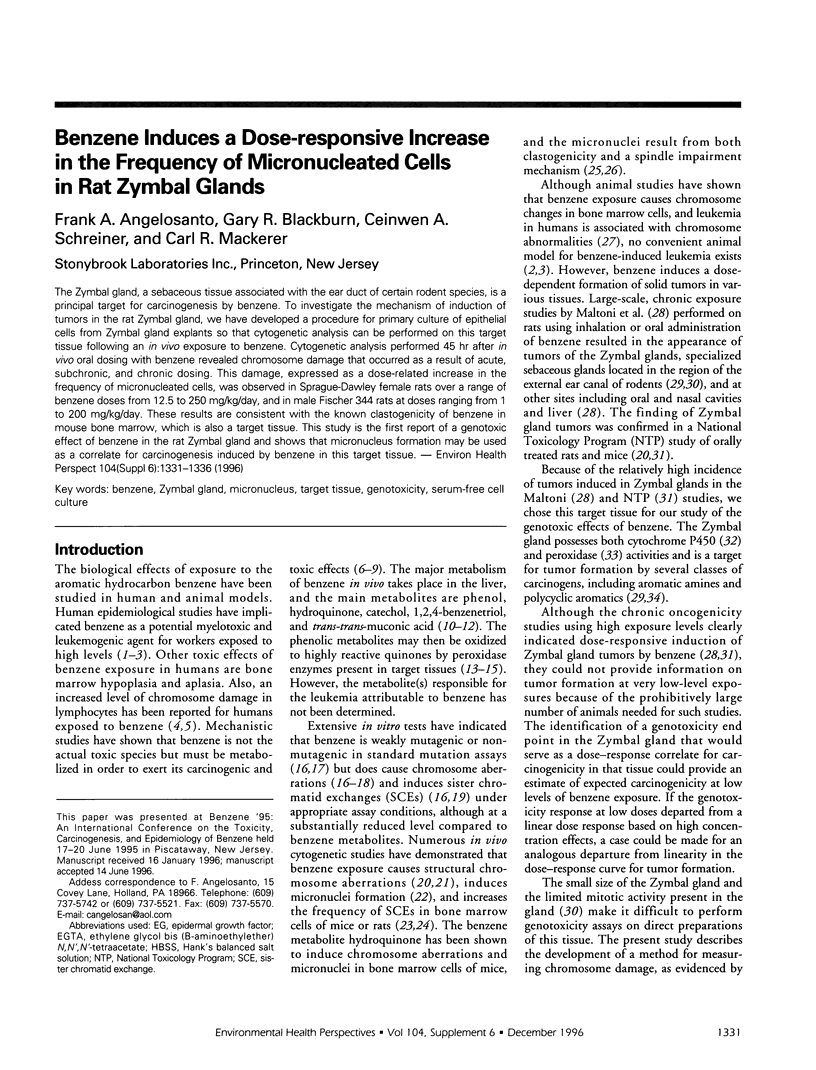
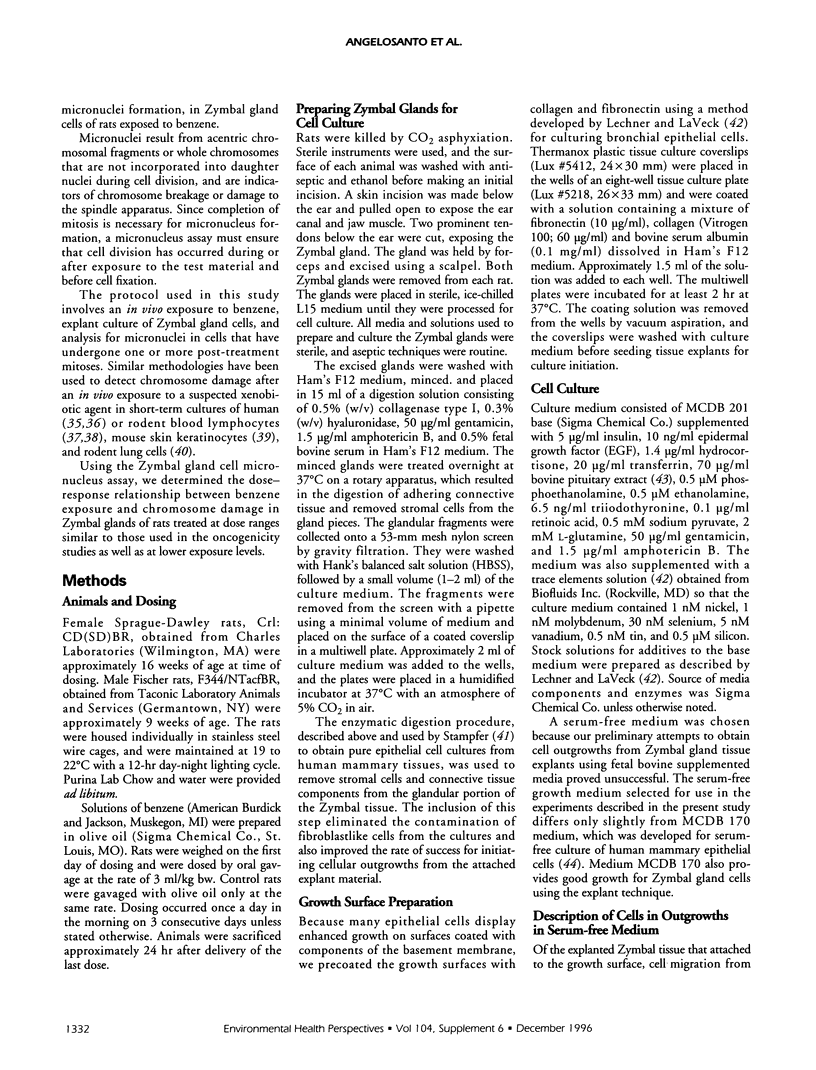
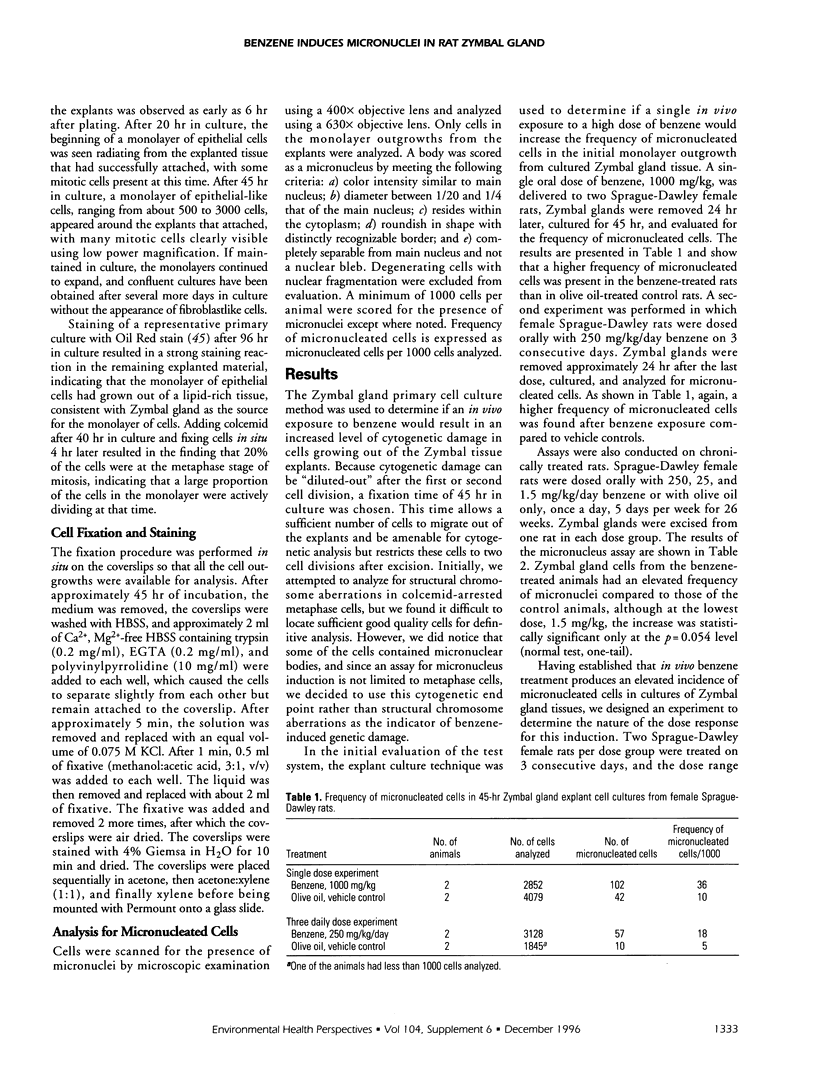
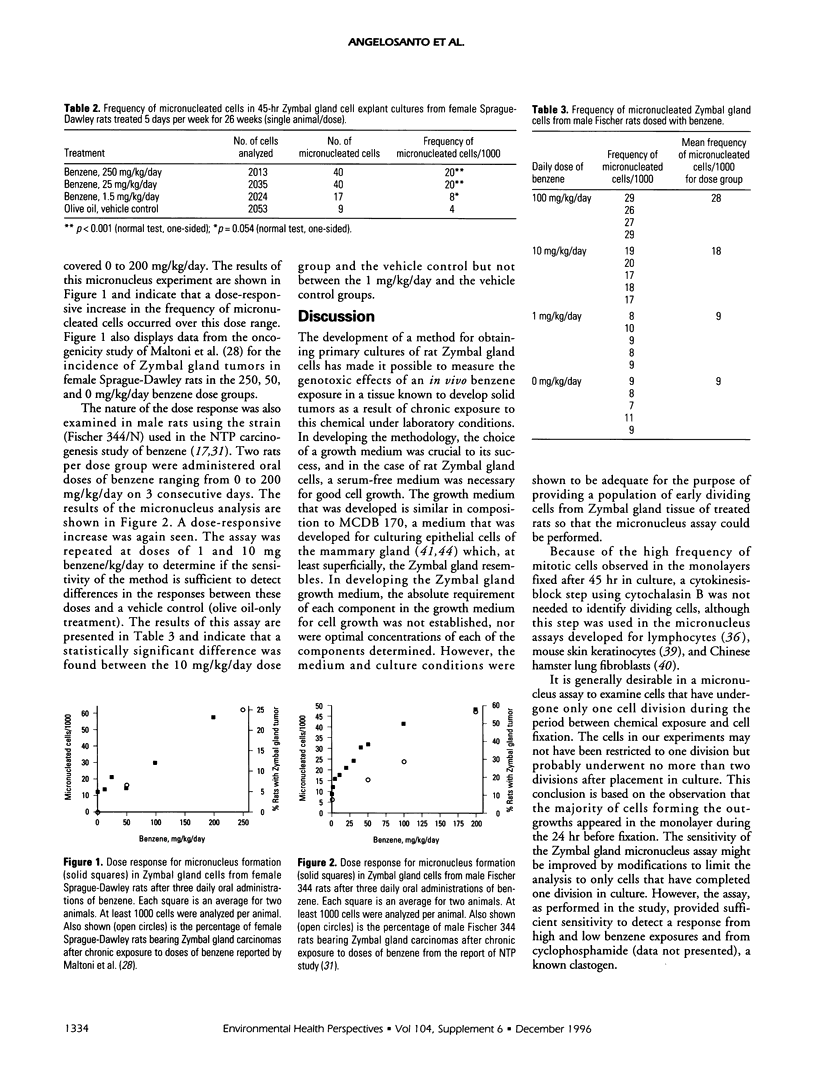
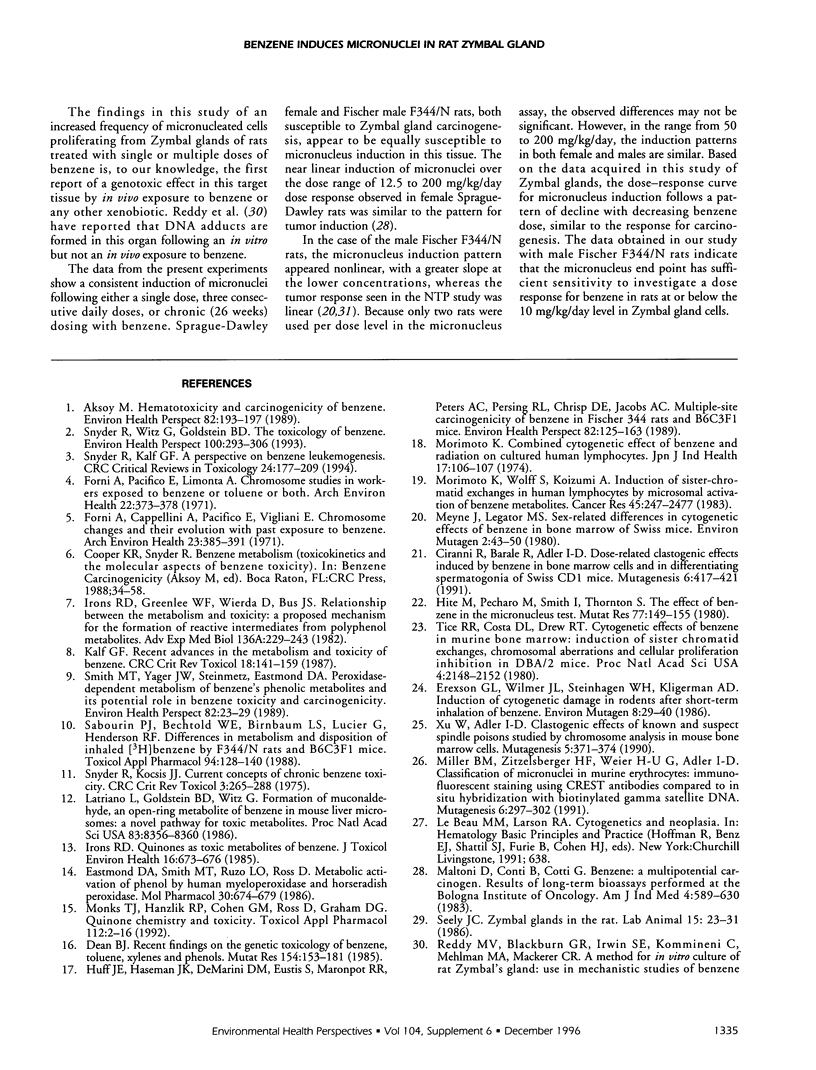
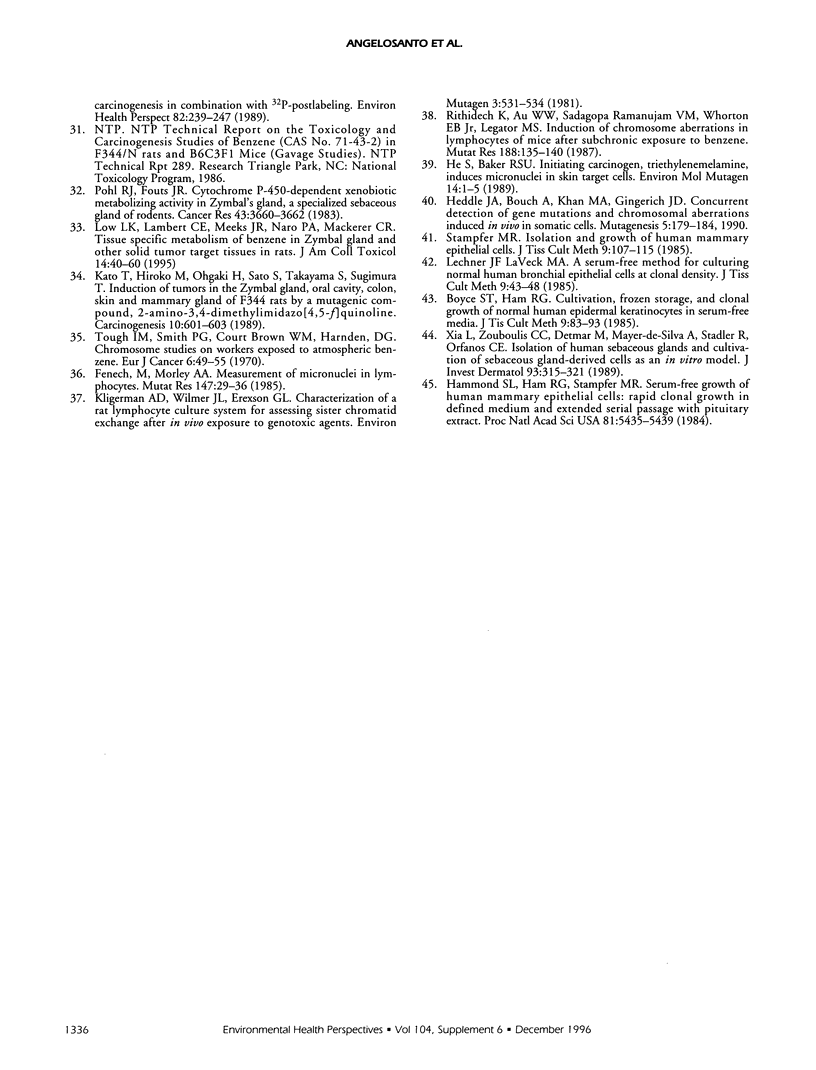
Selected References
These references are in PubMed. This may not be the complete list of references from this article.
- Aksoy M. Hematotoxicity and carcinogenicity of benzene. Environ Health Perspect. 1989 Jul;82:193–197. doi: 10.1289/ehp.8982193. [DOI] [PMC free article] [PubMed] [Google Scholar]
- Ciranni R., Barale R., Adler I. D. Dose-related clastogenic effects induced by benzene in bone marrow cells and in differentiating spermatogonia of Swiss CD1 mice. Mutagenesis. 1991 Sep;6(5):417–421. doi: 10.1093/mutage/6.5.417. [DOI] [PubMed] [Google Scholar]
- Dean B. J. Recent findings on the genetic toxicology of benzene, toluene, xylenes and phenols. Mutat Res. 1985 Nov;154(3):153–181. doi: 10.1016/0165-1110(85)90016-8. [DOI] [PubMed] [Google Scholar]
- Eastmond D. A., Smith M. T., Ruzo L. O., Ross D. Metabolic activation of phenol by human myeloperoxidase and horseradish peroxidase. Mol Pharmacol. 1986 Dec;30(6):674–679. [PubMed] [Google Scholar]
- Erexson G. L., Wilmer J. L., Steinhagen W. H., Kligerman A. D. Induction of cytogenetic damage in rodents after short-term inhalation of benzene. Environ Mutagen. 1986;8(1):29–40. doi: 10.1002/em.2860080104. [DOI] [PubMed] [Google Scholar]
- Fenech M., Morley A. A. Measurement of micronuclei in lymphocytes. Mutat Res. 1985 Feb-Apr;147(1-2):29–36. doi: 10.1016/0165-1161(85)90015-9. [DOI] [PubMed] [Google Scholar]
- Fori A., Pacifico E., Limonta A. Chromosome studies in workers exposed to benzene or toluene or both. Arch Environ Health. 1971 Mar;22(3):373–378. [PubMed] [Google Scholar]
- Forni A. M., Cappellini A., Pacifico E., Vigliani E. C. Chromosome changes and their evolution in subjects with past exposure to benzene. Arch Environ Health. 1971 Nov;23(5):385–391. doi: 10.1080/00039896.1971.10666024. [DOI] [PubMed] [Google Scholar]
- Hammond S. L., Ham R. G., Stampfer M. R. Serum-free growth of human mammary epithelial cells: rapid clonal growth in defined medium and extended serial passage with pituitary extract. Proc Natl Acad Sci U S A. 1984 Sep;81(17):5435–5439. doi: 10.1073/pnas.81.17.5435. [DOI] [PMC free article] [PubMed] [Google Scholar]
- He S. I., Baker R. S. Initiating carcinogen, triethylenemelamine, induces micronuclei in skin target cells. Environ Mol Mutagen. 1989;14(1):1–5. doi: 10.1002/em.2850140102. [DOI] [PubMed] [Google Scholar]
- Heddle J. A., Bouch A., Khan M. A., Gingerich J. D. Concurrent detection of gene mutations and chromosomal aberrations induced in vivo in somatic cells. Mutagenesis. 1990 Mar;5(2):179–184. doi: 10.1093/mutage/5.2.179. [DOI] [PubMed] [Google Scholar]
- Hite M., Pecharo M., Smith I., Thornton S. The effect of benzene in the micronucleus test. Mutat Res. 1980 Feb;77(2):149–155. doi: 10.1016/0165-1218(80)90132-9. [DOI] [PubMed] [Google Scholar]
- Huff J. E., Haseman J. K., DeMarini D. M., Eustis S., Maronpot R. R., Peters A. C., Persing R. L., Chrisp C. E., Jacobs A. C. Multiple-site carcinogenicity of benzene in Fischer 344 rats and B6C3F1 mice. Environ Health Perspect. 1989 Jul;82:125–163. doi: 10.1289/ehp.8982125. [DOI] [PMC free article] [PubMed] [Google Scholar]
- Irons R. D. Quinones as toxic metabolites of benzene. J Toxicol Environ Health. 1985;16(5):673–678. doi: 10.1080/15287398509530777. [DOI] [PubMed] [Google Scholar]
- Kalf G. F. Recent advances in the metabolism and toxicity of benzene. Crit Rev Toxicol. 1987;18(2):141–159. doi: 10.3109/10408448709089859. [DOI] [PubMed] [Google Scholar]
- Kato T., Migita H., Ohgaki H., Sato S., Takayama S., Sugimura T. Induction of tumors in the Zymbal gland, oral cavity, colon, skin and mammary gland of F344 rats by a mutagenic compound, 2-amino-3,4-dimethylimidazo[4,5-f]quinoline. Carcinogenesis. 1989 Mar;10(3):601–603. doi: 10.1093/carcin/10.3.601. [DOI] [PubMed] [Google Scholar]
- Kligerman A. D., Wilmer J. L., Erexson G. L. Characterization of a rat lymphocyte culture system for assessing sister chromatid exchange after in vivo exposure to genotoxic agents. Environ Mutagen. 1981;3(5):531–543. doi: 10.1002/em.2860030505. [DOI] [PubMed] [Google Scholar]
- Latriano L., Goldstein B. D., Witz G. Formation of muconaldehyde, an open-ring metabolite of benzene, in mouse liver microsomes: an additional pathway for toxic metabolites. Proc Natl Acad Sci U S A. 1986 Nov;83(21):8356–8360. doi: 10.1073/pnas.83.21.8356. [DOI] [PMC free article] [PubMed] [Google Scholar]
- Livingstone D. J. Pattern recognition methods in rational drug design. Methods Enzymol. 1991;203:613–638. doi: 10.1016/0076-6879(91)03032-c. [DOI] [PubMed] [Google Scholar]
- Maltoni C., Conti B., Cotti G. Benzene: a multipotential carcinogen. Results of long-term bioassays performed at the Bologna Institute of Oncology. Am J Ind Med. 1983;4(5):589–630. doi: 10.1002/ajim.4700040503. [DOI] [PubMed] [Google Scholar]
- Meyne J., Legator M. S. Sex-related differences in cytogenetic effects of benzene in the bone marrow of Swiss mice. Environ Mutagen. 1980;2(1):43–50. doi: 10.1002/em.2860020107. [DOI] [PubMed] [Google Scholar]
- Miller B. M., Zitzelsberger H. F., Weier H. U., Adler I. D. Classification of micronuclei in murine erythrocytes: immunofluorescent staining using CREST antibodies compared to in situ hybridization with biotinylated gamma satellite DNA. Mutagenesis. 1991 Jul;6(4):297–302. doi: 10.1093/mutage/6.4.297. [DOI] [PubMed] [Google Scholar]
- Monks T. J., Hanzlik R. P., Cohen G. M., Ross D., Graham D. G. Quinone chemistry and toxicity. Toxicol Appl Pharmacol. 1992 Jan;112(1):2–16. doi: 10.1016/0041-008x(92)90273-u. [DOI] [PubMed] [Google Scholar]
- Pohl R. J., Fouts J. R. Cytochrome P-450-dependent xenobiotic metabolizing activity in Zymbal's gland, a specialized sebaceous gland of rodents. Cancer Res. 1983 Aug;43(8):3660–3662. [PubMed] [Google Scholar]
- Rithidech K., Au W. W., Ramanujam V. M., Whorton E. B., Jr, Legator M. S. Induction of chromosome aberrations in lymphocytes of mice after subchronic exposure to benzene. Mutat Res. 1987 Jun;188(2):135–140. doi: 10.1016/0165-1218(87)90102-9. [DOI] [PubMed] [Google Scholar]
- Sabourin P. J., Bechtold W. E., Birnbaum L. S., Lucier G., Henderson R. F. Differences in the metabolism and disposition of inhaled [3H]benzene by F344/N rats and B6C3F1 mice. Toxicol Appl Pharmacol. 1988 Jun 15;94(1):128–140. doi: 10.1016/0041-008x(88)90343-2. [DOI] [PubMed] [Google Scholar]
- Smith M. T., Yager J. W., Steinmetz K. L., Eastmond D. A. Peroxidase-dependent metabolism of benzene's phenolic metabolites and its potential role in benzene toxicity and carcinogenicity. Environ Health Perspect. 1989 Jul;82:23–29. doi: 10.1289/ehp.898223. [DOI] [PMC free article] [PubMed] [Google Scholar]
- Snyder R., Kalf G. F. A perspective on benzene leukemogenesis. Crit Rev Toxicol. 1994;24(3):177–209. doi: 10.3109/10408449409021605. [DOI] [PubMed] [Google Scholar]
- Snyder R., Kocsis J. J. Current concepts of chronic benzene toxicity. CRC Crit Rev Toxicol. 1975 Jun;3(3):265–288. doi: 10.3109/10408447509079860. [DOI] [PubMed] [Google Scholar]
- Snyder R., Witz G., Goldstein B. D. The toxicology of benzene. Environ Health Perspect. 1993 Apr;100:293–306. doi: 10.1289/ehp.93100293. [DOI] [PMC free article] [PubMed] [Google Scholar]
- Tice R. R., Costa D. L., Drew R. T. Cytogenetic effects of inhaled benzene in murine bone marrow: induction of sister chromatid exchanges, chromosomal aberrations, and cellular proliferation inhibition in DBA/2 mice. Proc Natl Acad Sci U S A. 1980 Apr;77(4):2148–2152. doi: 10.1073/pnas.77.4.2148. [DOI] [PMC free article] [PubMed] [Google Scholar]
- Tough I. M., Smith P. G., Court Brown W. M., Harnden D. G. Chromosome studies on workers exposed to atmospheric benzene. The possible influence of age. Eur J Cancer. 1970 Feb;6(1):49–55. doi: 10.1016/0014-2964(70)90053-8. [DOI] [PubMed] [Google Scholar]
- Xia L. Q., Zouboulis C., Detmar M., Mayer-da-Silva A., Stadler R., Orfanos C. E. Isolation of human sebaceous glands and cultivation of sebaceous gland-derived cells as an in vitro model. J Invest Dermatol. 1989 Sep;93(3):315–321. [PubMed] [Google Scholar]
- Xu W., Adler I. D. Clastogenic effects of known and suspect spindle poisons studied by chromosome analysis in mouse bone marrow cells. Mutagenesis. 1990 Jul;5(4):371–374. doi: 10.1093/mutage/5.4.371. [DOI] [PubMed] [Google Scholar]


